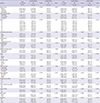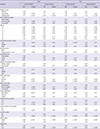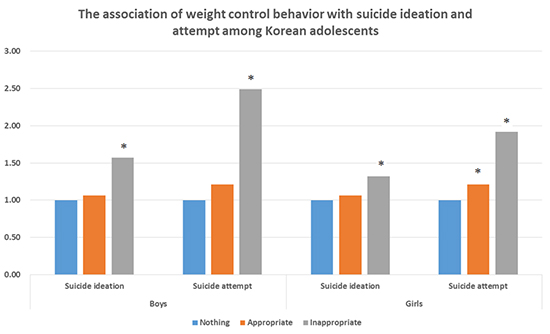1. Patton GC, Coffey C, Sawyer SM, Viner RM, Haller DM, Bose K, Vos T, Ferguson J, Mathers CD. Global patterns of mortality in young people: a systematic analysis of population health data. Lancet. 2009; 374:881–892.
2. Statistics Korea. Death and Cause of Death in Korea: 2013. Daejeon: Statistics Korea;2014.
3. Hawton K, Saunders KE, O'Connor RC. Self-harm and suicide in adolescents. Lancet. 2012; 379:2373–2382.
4. Fergusson DM, Beautrais AL, Horwood LJ. Vulnerability and resiliency to suicidal behaviours in young people. Psychol Med. 2003; 33:61–73.
5. Eaton DK, Lowry R, Brener ND, Galuska DA, Crosby AE. Associations of body mass index and perceived weight with suicide ideation and suicide attempts among US high school students. Arch Pediatr Adolesc Med. 2005; 159:513–519.
6. Kim DS, Cho Y, Cho SI, Lim IS. Body weight perception, unhealthy weight control behaviors, and suicidal ideation among Korean adolescents. J Sch Health. 2009; 79:585–592.
7. Cheung PC, Ip PL, Lam ST, Bibby H. A study on body weight perception and weight control behaviours among adolescents in Hong Kong. Hong Kong Med J. 2007; 13:16–21.
8. Phelps L, Johnston LS, Jimenez DP, Wilczenski FL, Andrea RK, Healy RW. Figure preference, body dissatisfaction, and body distortion in adolescence. J Adolesc Res. 1993; 8:297–310.
9. ter Bogt TF, van Dorsselaer SA, Monshouwer K, Verdurmen JE, Engels RC, Vollebergh WA. Body mass index and body weight perception as risk factors for internalizing and externalizing problem behavior among adolescents. J Adolesc Health. 2006; 39:27–34.
10. Eisenberg ME, Neumark-Sztainer D, Story M, Perry C. The role of social norms and friends' influences on unhealthy weight-control behaviors among adolescent girls. Soc Sci Med. 2005; 60:1165–1173.
11. Lim H, Wang Y. Body weight misperception patterns and their association with health-related factors among adolescents in South Korea. Obesity (Silver Spring). 2013; 21:2596–2603.
12. Talamayan KS, Springer AE, Kelder SH, Gorospe EC, Joye KA. Prevalence of overweight misperception and weight control behaviors among normal weight adolescents in the United States. ScientificWorldJournal. 2006; 6:365–373.
13. Field AE, Camargo CA Jr, Taylor CB, Berkey CS, Roberts SB, Colditz GA. Peer, parent, and media influences on the development of weight concerns and frequent dieting among preadolescent and adolescent girls and boys. Pediatrics. 2001; 107:54–60.
14. Neumark-Sztainer D, Wall M, Story M, Standish AR. Dieting and unhealthy weight control behaviors during adolescence: associations with 10-year changes in body mass index. J Adolesc Health. 2012; 50:80–86.
15. Kim MH. Eating habit, body image, and weight control behavior by BMI in Korean female high school students: using Korea youth risk behavior web-based survey 2010 data. Korean J Food Nutr. 2012; 25:579–589.
16. Ministry of Health and Welfare. Korea Centers for Disease Control and Prevention. The Tenth Korea Youth Risk Behavior Web-based Survey. Cheongju: Korea Centers for Disease Control and Prevention;2014.
17. Wheaton AG, Perry GS, Chapman DP, Croft JB. Self-reported sleep duration and weight-control strategies among U.S. high school students. Sleep. 2013; 36:1139–1145.
18. Neumark-Sztainer D, Wall M, Guo J, Story M, Haines J, Eisenberg M. Obesity, disordered eating, and eating disorders in a longitudinal study of adolescents: how do dieters fare 5 years later? J Am Diet Assoc. 2006; 106:559–568.
19. Stice E, Bearman SK. Body-image and eating disturbances prospectively predict increases in depressive symptoms in adolescent girls: a growth curve analysis. Dev Psychol. 2001; 37:597–607.
20. Cook SJ, MacPherson K, Langille DB. Far from ideal: weight perception, weight control, and associated risky behaviour of adolescent girls in Nova Scotia. Can Fam Physician. 2007; 53:678–684.
21. Neumark-Sztainer D, Story M, Dixon LB, Murray DM. Adolescents engaging in unhealthy weight control behaviors: are they at risk for other health-compromising behaviors? Am J Public Health. 1998; 88:952–955.
22. Neumark-Sztainer D, Hannan PJ. Weight-related behaviors among adolescent girls and boys: results from a national survey. Arch Pediatr Adolesc Med. 2000; 154:569–577.
23. Crow S, Eisenberg ME, Story M, Neumark-Sztainer D. Suicidal behavior in adolescents: relationship to weight status, weight control behaviors, and body dissatisfaction. Int J Eat Disord. 2008; 41:82–87.
24. Moon JS, Lee SY, Nam CM, Choi JM, Choe BK, Seo JW, Oh K, Jang MJ, Hwang SS, Yoo MH, et al. 2007 Korean National Growth Charts: review of developmental process and an outlook. Korean J Pediatr. 2008; 51:1–25.
25. Shin J, Choi Y, Han KT, Cheon SY, Kim JH, Lee SG, Park EC. The combined effect of subjective body image and body mass index (distorted body weight perception) on suicidal ideation. J Prev Med Public Health. 2015; 48:94–104.
26. Nylander I. The feeling of being fat and dieting in a school population. An epidemiologic interview investigation. Acta Sociomed Scand. 1971; 3:17–26.
27. Santos M, Richards CS, Bleckley MK. Comorbidity between depression and disordered eating in adolescents. Eat Behav. 2007; 8:440–449.
28. Birmaher B, Brent DA, Benson RS; American Academy of Child and Adolescent Psychiatry. Summary of the practice parameters for the assessment and treatment of children and adolescents with depressive disorders. J Am Acad Child Adolesc Psychiatry. 1998; 37:1234–1238.
29. Stice E, Davis K, Miller NP, Marti CN. Fasting increases risk for onset of binge eating and bulimic pathology: a 5-year prospective study. J Abnorm Psychol. 2008; 117:941–946.
30. Golden NH, Katzman DK, Kreipe RE, Stevens SL, Sawyer SM, Rees J, Nicholls D, Rome ES; Society For Adolescent Medicine. Eating disorders in adolescents: position paper of the Society for Adolescent Medicine. J Adolesc Health. 2003; 33:496–503.
31. Milos G, Spindler A, Hepp U, Schnyder U. Suicide attempts and suicidal ideation: links with psychiatric comorbidity in eating disorder subjects. Gen Hosp Psychiatry. 2004; 26:129–135.
32. Neumark-Sztainer D, Story M, Hannan PJ, Perry CL, Irving LM. Weight-related concerns and behaviors among overweight and nonoverweight adolescents: implications for preventing weight-related disorders. Arch Pediatr Adolesc Med. 2002; 156:171–178.
33. Whetstone LM, Morrissey SL, Cummings DM. Children at risk: the association between perceived weight status and suicidal thoughts and attempts in middle school youth. J Sch Health. 2007; 77:59–66.
34. United States Public Health Service, Office of the Surgeon General. Center for Mental Health Services (US). National Institute of Mental Health (US). Mental Health: a Report of the Surgeon General. Rockville, MD: Department of Health and Human Services;1999.
35. Daniels J. Weight and weight concerns: are they associated with reported depressive symptoms in adolescents? J Pediatr Health Care. 2005; 19:33–41.
36. Fishbein D, Pease SE. Diet, nutrition, and aggression. J Offender Rehabil. 1994; 21:117–144.








 PDF
PDF ePub
ePub Citation
Citation Print
Print




 XML Download
XML Download